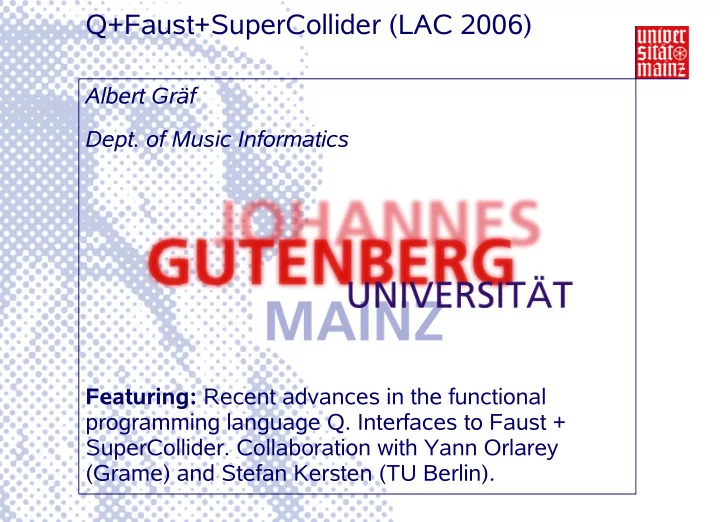

Q+Faust+SuperCollider (LAC 2006) Q+Faust+SuperCollider Albert Gräf Dept. of Music Informatics Featuring: Recent advances in the functional programming language Q. Interfaces to Faust + SuperCollider. Collaboration with Yann Orlarey (Grame) and Stefan Kersten (TU Berlin).
Q+Faust+SuperCollider About Q programs are collections sqr X = X*X; of algebraic equations sqr 2+sqr (2+3) 2*2+sqr (2+3) expression evaluation 4+sqr (2+3) 4+sqr 5 by term rewriting 4+5*5 4+25 29 gcdiv X Y = gcdiv Y (X mod Y) if Y>0; conditional equations = X otherwise ; and tail recursion fib N = A where (A,B) = fibs N; local variable fibs N = (0,1) if N<=0; definitions = (B,A+B) where (A,B) = fibs (N-1); qsort [] = []; pattern matching and qsort [X|Xs] = qsort (filter (<X) Xs) ++ higher-order functions [X] ++ qsort (filter (>=X) Xs);
Q+Faust+SuperCollider Why Functional Programming? – General FP advantages: powerful abstractions, mathematical elegance, higher-order functions, referential transparency. – Added benefits of “modern-style” FP: Currying, algebraic data types, equational definitions, pattern matching, lazy evaluation. Better abstractions, less code. – Special benefits for real-time multimedia applications: It's all about processing signals and event sequences, which can easily be modelled as higher-order functions and streams.
Q+Faust+SuperCollider The Main Ingredients of Q Term rewriting as a programming language (O'Donnell et al 1985) + rule priorities, conditions, local variable definitions + modern style FP syntax (infix application, currying, higher-order functions) + algebraic data types (free term algebra) + dynamic OO typing (Smalltalk style) + special forms (lazy evaluation)
Q+Faust+SuperCollider Multimedia: Library MidiShare, Faust, C/C++ PortAudio, OSC/SC3 , OpenAL, Xine Standard Library: Q-SWIG lists, streams, Q Interpreter containers, Scientific lambda calculus, ... programming: Octave, OpenDX, Graph library POSIX: I/O, GUI+Graphics: processes, Tcl/Tk, Gnocl, Web+Databases: threads, sockets, GGI, ImageMagick, Apache module, regexps, ... OpenGL XML+XSLT, Curl, ODBC, SQLite
Q+Faust+SuperCollider MidiShare Interface MidiMsg object note_on 0 64 127 MIDI file midi_get [(0,note_on 0 64 127),...] Processing midi_send Sequencing midi_send note_on 1 60 64 note_on 0 64 127 dynamic routing midi_get MidiShare client Synthesis
Q+Faust+SuperCollider Audio Interface sndfile audio sound audio files devices wave data libsndfile portaudio wave GGI SRC FFT libggi fftw3 libsamplerate
Q+Faust+SuperCollider Faust Interface faust -a q.cpp && c++ .dsp source .so shared lib faust_init Q-Faust FaustDSP object faust_compute faust_info get, put control data audio data UI description
Q+Faust+SuperCollider Faust Ex. 1: A Simple Organ Demo // control variables vol = nentry("vol", 0.3, 0, 10, 0.01); // % attack = nentry("attack", 0.01, 0, 1, 0.001); // sec decay = nentry("decay", 0.3, 0, 1, 0.001); // sec sustain = nentry("sustain", 0.5, 0, 1, 0.01); // % release = nentry("release", 0.2, 0, 1, 0.001); // sec freq = nentry("freq", 440, 20, 20000, 1); // Hz gain = nentry("gain", 1.0, 0, 10, 0.01); // % gate = button("gate"); // 0/1 // additive synth: 3 sine oscillators with adsr envelop process = (osc(freq)+0.5*osc(2*freq)+0.25*osc(3*freq)) * (gate : adsr(attack, decay, sustain, release)) * gain * vol;
Q+Faust+SuperCollider Q Ex. 1: Monophonic Synthesizer Demo def [FREQ,GAIN,GATE] = map (CTLD!) ["freq","gain","gate"]; map MIDI note freq N = 440*2^((N-69)/12); numbers and gain V = V/127; velocities play N V = put FREQ (freq N) || put GAIN (gain V) || put GATE 1; damp = put GATE 0; start and stop a note process (_,_,_,note_on _ N V) = play N V if V>0; = damp if not isnum (get FREQ) or else process MIDI (freq N = get FREQ); messages midi_loop = process (midi_get IN) || midi_loop;
Q+Faust+SuperCollider Faust Ex. 2: Eight Voices freq(i) = nentry("freq%i", 440, 20, 20000, 1); // Hz gain(i) = nentry("gain%i", 0.3, 0, 10, 0.01); // % gate(i) = button("gate%i"); // 0/1 voice index // one synth per voice voice(i) = (osc(freq(i))+0.5*osc(2*freq(i))+ 0.25*osc(3*freq(i))) * (gate(i) : adsr(attack, decay, sustain, release)) * gain(i); nvoices = 8; process = sum(i, nvoices, voice(i)) * vol;
Q+Faust+SuperCollider Q Ex. 2: Polyphonic Synthesizer Demo /* Simple voice allocation algorithm. */ init_voices = ([],[0..7]); new_voice (P,Q) N V = play I N V || (P,Q) where [I|Q] = Q, P = append P (I,N); = damp I || sleep 0.01 || play I N V || (P,Q) “steal” a where [(I,_)|P] = P, P = append P (I,N); voice free_voice ([(I,N)|P],Q) N = damp I || (P,append Q I); free_voice ([X|P],Q) N = ([X|P],Q) where (P,Q) = free_voice (P,Q) N; free_voice ([],Q) _ = ([],Q);
Q+Faust+SuperCollider Q+SuperCollider+Faust Q Q-SC Q-Faust interface interface (via OSC) q.cpp, osc.q, sc.q faust.q SuperCollider Faust SC-Faust interface supercollider.cpp
Q+Faust+SuperCollider Q-OSC/SuperCollider Interface osc_message "/n_set" (4711,"freq",440) osc, sc sc_send sc_recv sc "SynthDef ..." sc_source "syn.sc" via UDP sc_start synthdefs scsynth sclang SC sound server SC language OSC
Q+Faust+SuperCollider Q n_set ARGS = sc_send (osc_message "/n_set" ARGS); play I N V = n_set (I,"freq",freq N,"gain",gain V, "gate",1); damp I = n_set (I,"gate",0); SuperCollider SynthDef("organ", { arg gate = 0, freq = 440, gain = 0.3, vol = 1.0; var sig; sig = FOrgan.ar(gate: gate, freq: freq, vol: vol); Out.ar(0, Pan2.ar(sig, 0, 1)); }) Demo
Q+Faust+SuperCollider Advantages of the Q+SC+Faust Combo You get the best of three worlds : – SuperCollider can be extended with plugins written in Faust. – All hard real-time processing is done in SuperCollider. – Q can be used to do the high-level control and provide the system and user interface. – Existing SuperCollider code can be reused in Q applications.
Recommend
More recommend